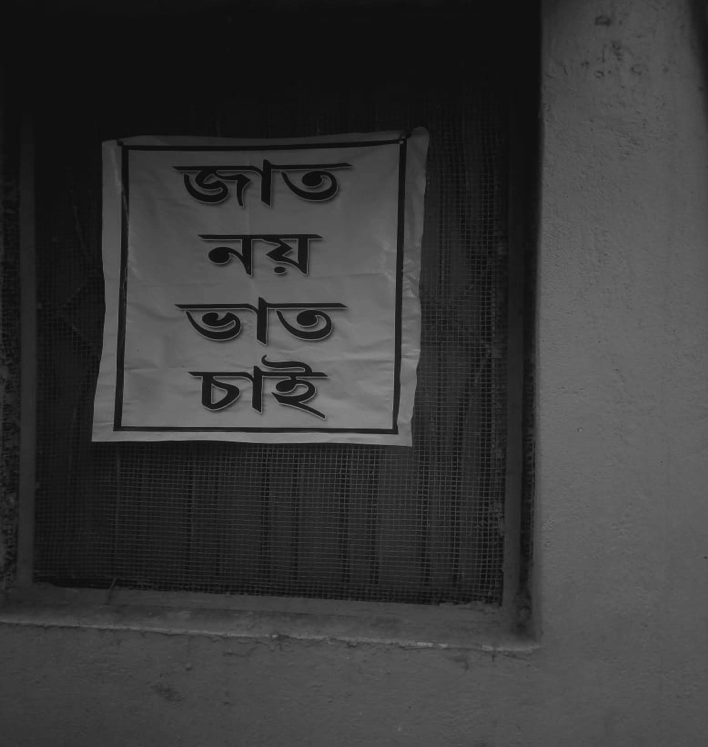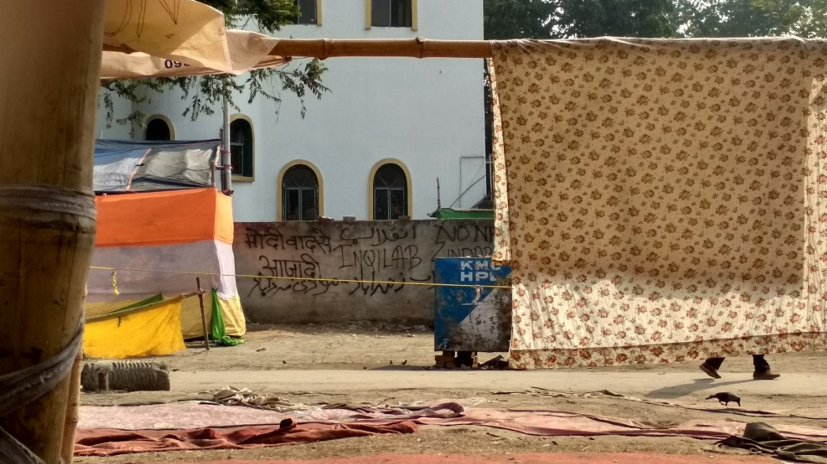Guest post by Debaroti Chakraborty, Presidency University. As a researcher-artist she focuses on making cross-cultural and inter-cultural performances based on lived experiences, narratives and oral history. She is a theatre and movement practitioner. This post is the seventh instalment of the Border Criminologies Themed Week on the “Citizenship, Identity and Belongingness: Narratives from India” organised by Rimple Mehta.
Calcutta (officially known as Kolkata), over the last decade, has lurched towards being the decadent home in the popular march facing mobile and digital India. The traffic of the city sketches a familiar map – the “able-bodied-minded” generation migrates for job opportunities, practices in the arts are inevitably voluntary recreational activities crying for resources and public support, the older generation wallows in loneliness and scoffs at the young who refuse to move, Rajarhat stretches through towers and lights while families survive on the streets of Central Avenue and we perform the hackneyed drill of walking through colonial history and the radical seventies with friends who visit the city. We feed on the accolades of being the city with a soul, with a song and with sweetness as compensatory ambrosia. What suddenly stoked such a situation of complacency that thousands (old and new) took to the streets over the last few months?
In December 2019, I was invited by the Department of Comparative Literature at Jadavpur University, Kolkata, to direct a students’ performance for an International Forum on Megacities. Exactly around that time, all creative and academic processes got scrambled as we witnessed in utter dismay the violence on students inside Jawaharlal Nehru University as the police played the mute spectator. State violence on students inside Jamia Milia University and Aligarh University for protesting against the Citizenship Amendment Act 2019 (CAA) - and attempts to gag voices of dissent across India by the abrasive state apparatus driven by the ruling Bharata Janata Party at the centre continued to shock us. These incidents reveal the unscrupulous strategy of the government by which on one hand it has targeted to dismantle the protests of the students’ community that seek to expose how CAA and National Register of Citizens (NRC) defy the secular fabric of India, and on the other hand to shift public attention from the real economic and political failures of the government.
While I had been trying hard to pull out play scripts that echo the theme of the seminar, we failed to be motivated enough to meet for rehearsals. Instead, I began to think of intellectual and artistic ways to understand the cultural history of Calcutta, its vein of pluralism, the lived spaces of the city, the religious polyglot and layered sense of belonging more deeply so that this can meaningfully feed into the passionate and intuitive protests. I designed a performance walk through the city, with my colleagues and students as co-walkers, to explore a few distinct neighbourhoods in the city from the wake of an early hour rolling into a mundane working day. The walk was meant to evoke a visceral understanding of the mapped spaces, a narrative of experience through our senses – sounds we record, the objects we find and how they relate to identities and inhabited realities of a space, smells that we register, people we meet, feelings we have, photographs we capture and so forth. This walk led us to the awareness of a cultural history that often overlaps or contradicts with our personal histories to create an undeniably multi-toned understanding of ‘gaze’, of public and private spaces, of pluralism and inclusiveness, of co-existence and of what constitutes moments of an insider as well as an intruder in one’s own city. This article will present some snippets of sensuous knowing in the course of the walk that reclaims city space as lived, as inhabited, as encountered, as appropriated, as experienced, as abandoned - all of which relate to a personal sense of belonging as opposed to the statist strategies of exclusion.

Google map laid out an indefinite area when we keyed in Sonagachi, the largest red-light district in South Asia. We hesitated to mention the neighbourhood to our bus driver since we were aware of the social taboo around the red light district and anticipated an awkward response from him. Instead we asked him to stop opposite Jatin Moitra park at 7:30 am. We strolled into the thin alley, Durgacharan Mitra Street, tucked out of sight from the gigantic Chittaranjan Avenue. An unfamiliar stifling feeling ran through my body as I observed the choked houses leaning on each other along the street. Every door, window and balcony were sealed with tarpaulin or cloth. An overwhelming contrast struck me in a while – the neighbourhood has grown around the myth of a notorious muslim dacoit-turned-warrior Sanaullah Gazi (turned into Sonagachi meaning ‘golden tree’ in Bengali), while many houses in the street are flanked by pictures of Hindu gods and goddesses at the entrance. One of my co-walkers and student, observed a placard on a closed window that loosely translates as give us food, don’t ask about caste. The explicit religious symbols displayed on the surface validated the shared space of a community instead of expressing divisive identities. Sanaullah Gazi’s mazaar (a mausoleum or shrine dedicated to a saint or religious leader) stood quietly in the centre of regular chores that bestowed a sense of everydayness and domesticity. The words of caution and taboo surrounding the neighbourhood began to melt into the tunes of kajri (a semi-classical genre of music popular in Uttar Pradesh) that poured out from a record player in one of the houses. Suddenly, I could put a finger on my claustrophobia - I felt like an intruder who has burst into private spaces of a family.
From Sonagachi, located in the Northern part of Calcutta, we travelled down through the belly of the city to Park Circus in the central part. For years, this neighbourhood is home to a large muslim community though it records a growing cosmopolitan texture in recent times.

The tri-colour national flag swayed untiringly over Park Circus Maidan as women who have stayed overnight were leaving while others joined to sit-in for the day at around 10 a.m. Park Circus Maidan, the playground which hosts many circus companies in winters, has been home to many women, protesting against CAA and NRC this winter. A sit-in protest initiated by 60 women has organically grown into a huge movement with thousands of participants joining without any political or organizational banner. Many of these muslim women, from across class and social location, have stepped out of their homes to join the movement in order to protect their home - the nation, as they unanimously said. In my conversations with the protestors, I understood how they were overturning the ruling party’s rhetoric of beti bachao beti padao (save girls, educate girls) for winning vote banks inside out to make a dig into the regressive fundamentalist regime and to re-claim nationalism. Park Circus Maidan, has emerged into a gendered space of resilience, marked by the practices and the objects found lying on the ground. A co-walker and student collected broken pieces of bangles, a few bobby pins, hair clips, kids’ deserted shoes and an empty vial of polio vaccine! These objects speak to the identities and roles that the women are writing into the protest as mothers, as wives, as homemakers, as teachers and others. The passion with which they are committing to a sense of belonging to this land is unspeakable. A woman, who leaves her five-year-old at home to join the protest every day, said with a firm conviction that she would rather continue the resistance and lie in her grave in this land rather than die in a detention camp.
This walk encouraged an art of understanding the ordinary, a moment of illumination, the small scale, the microcosmic lived experiences that helps to reach out towards a larger picture. It involved an immersive experience - ‘The splinter in your eyes is the best magnifying glass’ as Adorno says. Adorno explains that it is only by trying to say the unsayable, the outside of language, the mimetic, the sensual, the non-conceptual through creativity that we can approach a ‘politics’ that undercuts identity thinking and crisscrosses binary thinking/territories and resists appropriation.
Any comments about this post? Get in touch with us! Send us an email, or post a comment here or on Facebook. You can also tweet us.
__________
How to cite this blog post (Harvard style)
Chakraborty, D. (2020). Walking as Feeling as Belonging. Available at: https://www.law.ox.ac.uk/research-subject-groups/centre-criminology/centreborder-criminologies/blog/2020/02/walking-feeling (Accessed [date])
Share:








